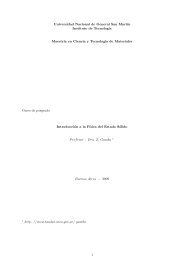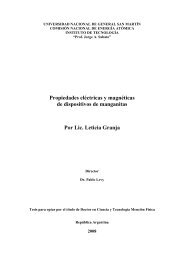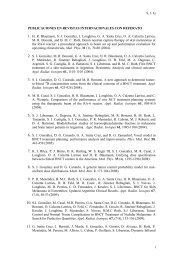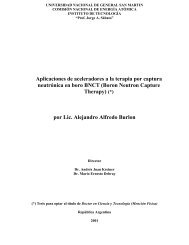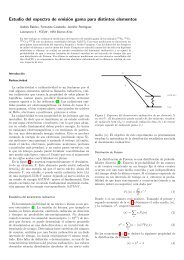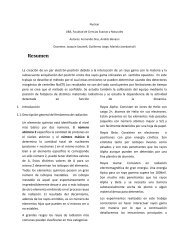Familia de Mapas del Panadero Como Ambiente Caótico de la ...
Familia de Mapas del Panadero Como Ambiente Caótico de la ...
Familia de Mapas del Panadero Como Ambiente Caótico de la ...
Create successful ePaper yourself
Turn your PDF publications into a flip-book with our unique Google optimized e-Paper software.
CAPÍTULO 5. CAMINATA ACOPLADA A PANADERO 59<br />
σ<br />
20<br />
18<br />
16<br />
14<br />
12<br />
10<br />
8<br />
6<br />
4<br />
2<br />
fam 1 (Baker)<br />
fam 2<br />
fam 3<br />
fam 4<br />
fam 5<br />
fam 6 (Many Coins)<br />
0<br />
0 4 8 12 16 20 24 28 32 36 40 44 48 52 56 60 64 68 72 76 80<br />
t<br />
F(t)=t 1/2<br />
Figura 5.5: Varianza <strong>de</strong>l caminante acop<strong>la</strong>do a <strong>la</strong> familia <strong>de</strong>l pana<strong>de</strong>ro <strong>de</strong> 6 qubits. El caminante tiene<br />
un comportamiento clásico hasta tiempos <strong>de</strong>l or<strong>de</strong>n <strong>de</strong> los qubits <strong>de</strong>l pana<strong>de</strong>ro.<br />
log 2 (σ)<br />
64<br />
32<br />
16<br />
8<br />
4<br />
2<br />
fam 1<br />
t=6<br />
fam 2<br />
fam 3<br />
fam 4<br />
fam 5<br />
fam 6<br />
t=64<br />
1<br />
1 2 4 8 16<br />
log (t)<br />
2<br />
32 64 128 256<br />
f(t)=t/8<br />
f(t)=t 1/2<br />
Figura 5.6: Varianza <strong>de</strong>l caminante acop<strong>la</strong>do a <strong>la</strong> familia <strong>de</strong>l pana<strong>de</strong>ro <strong>de</strong> 6 qubits en esca<strong>la</strong> logarítmica.<br />
Si observamos el gráfico 5.5 <strong>de</strong> <strong>la</strong> varianza en función <strong>de</strong>l tiempo, en esca<strong>la</strong> logarítmica,<br />
notamos que existen 3 comportamientos distintos:<br />
En 0 ≤ t < log 2(N) <strong>la</strong> varianza crece ∝ √ t (comportamiento clásico)<br />
En log 2(N) ≤ t < N crecen en forma compleja<br />
En N ≤ t < ∞ <strong>la</strong> varianza crece ∝ t (comportamiento cuántico)<br />
En el caso <strong>de</strong> varias monedas in<strong>de</strong>pendientes (Bl,l) para tiempos menores que el número <strong>de</strong><br />
monedas, es trivial enten<strong>de</strong>r su comportamiento clásico ya que no existe corre<strong>la</strong>ción entre <strong>la</strong>s<br />
monedas. Este comportamiento también se ve en los <strong>de</strong>más miembros <strong>de</strong> <strong>la</strong> familia <strong>de</strong>l pana<strong>de</strong>ro



